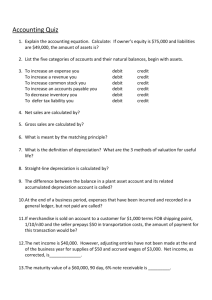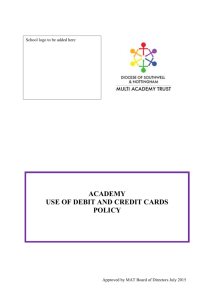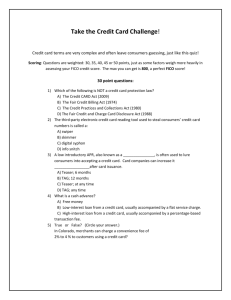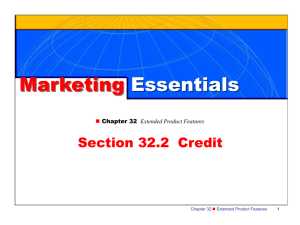Double Entry Booklet
advertisement
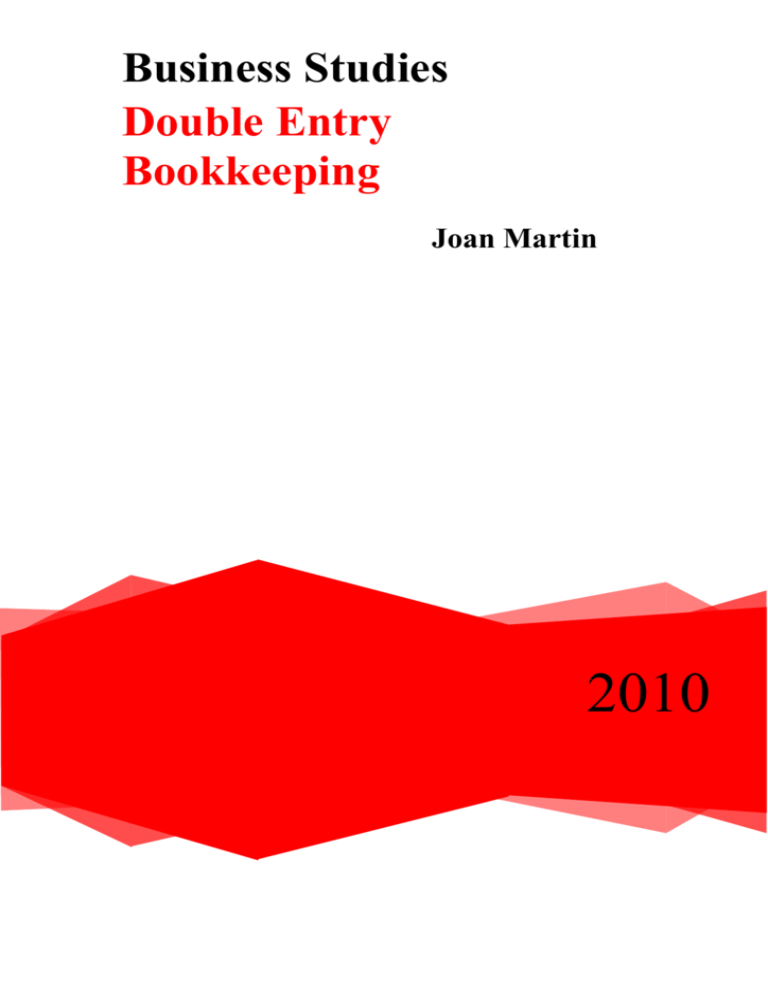
Business Studies Double Entry Bookkeeping Joan Martin 2010 Books of First Entry Across the Business Studies Course They appear all over the Buisness Studies course: Section A, parts b & c in long questions and Q1 Paper 2 (Higher Level). Students who do these questions well, tend to score highly and also do well in the Final Accounts question. In Section A – Double-entry book keeping questions appear in a number of different ways. Ledger Accounts There are two parts/accounts for each transaction. Students are asked to name the account and decide which side, whether it is on the Debit or Credit side. Example Daly Ltd purchased equipment by cheque. Account 1 ____Equipment Account________(Debit side)_____ Account 2 ____Bank Account_____________(Credit side)_____ When goods are purchased or sold there are three main ways of payment: 1. Bank Account (watch out for the words “lodged” or “cheque”) 2. Cash Account 3. Credit All Assets should be recorded in an account named after the asset e.g. Machinery Account All expenses should be recorded in an account named after the expense e.g. Insurance Account All goods purchased should be recorded in an account called Purchases Account. All goods sold should be recorded in an account called Sales Account. The same rule applies to goods returned e.g Sales Returns Account and Purchases Returns Account. Example 2008 Paper Section A Joan Martin 15/11/08 2 Credit Transactions This applies where goods are bought and sold ON CREDIT. This means goods are bought or sold now and payment is not received till a later date. The following is how to treat credit transactions Selling on Credit Sales Account and Debtors Account Buying on Credit Purchases A/C and Creditors Account Returning goods to Creditor Purchases Returns Account and Creditors Account Goods returned by a Debtor Sales Returns A/C and Debtors A/C Transaction Debit Credit Purchased goods on credit from B Giles Purchased equipment on credit from Dental Suplies Ltd Sold goods on credit to M Reilly Joan Martin 15/11/08 3 Layout of Accounts – T Accounts These types of questions appear all over the paper especially at the end of long questions. Students should complete all parts outlined below. There are two sides to T Accounts: Debit Side Credit Side As mentioned every transaction has two accounts. When posting a T- Account, each transaction will have an entry on both sides. Example Debit Date Details Account Name F € Date Details Credit F € Divides the T Account in two Monetary value of transaction (Folio) Reference to find other account of transaction Record of the other account Date of transaction When completing T Accounts students must always fill the following in on both the DEBIT AND CREDIT SIDES. Dates Details Folio € “DEBIT THE RECEIVER AND CREDIT THE GIVER” BALANCING T-ACCOUNTS These types of questions appear all over the paper from Section A short questions and part (c) of long questions and other long accounting questions. Joan Martin 15/11/08 4 Example Debit DATE DETAILS 1/3/08 Balance 10/3/08 Sales BANK ACCOUNT F € DATE b/d 14,000 3/3/08 SB 5,000 20/3/08 31/3/08 19,000 1/4/08 b/d 11,500 Balance DETAILS Purchases Insurane Balance Credit F € PB 4,500 GL 3,000 c/d 11,500 19,000 Add up both Debit and Credit side of account Insert Balance c/d on the smaller side Draw a single line and a double line to denote that the account is finished Put the larger amount in both total boxes i.e. accounts must show same totals to balance Calculate the Balance c/d by adding up the amounts and subtracting it from the total e.g. €11,500 The closing balance should be brought down (b/d) for the beginning of the next month. This closing balance b/d is on the debit side and will be used in the trial balance. Trial Balance This is list of entries from your ledger accounts to check that your double-entry bookkeeping is correct. Both sides should balance. If not then you check where you error is. You will have entries from three accounts: General Ledger Debtors Ledger Creditors ledger Junior Certificate Higher Level Question 1 Paper Two There are a number of questions asked in this question: Joan Martin 15/11/08 5 General Journal Day Books i.e. Sales and Purchases Analysed Cash Book Trial Balance General Journal This can be asked in Section A short questions. Students may be asked to complete some or all of the General Journal. Example A firm has the following Assets and Liabilities on 1 January 2008 Premises €200,000 Loan €80,000 Complete the General Journal below and record this and calculate the Ordinary Share Capital. DATE 1/1/08 General Journal DETAILS Premises Loan Ordinary Share Capital Assets, Liabilities and Capital on 1/1/08 F GL GL GL DEBIT 200,000 CREDIT 80,000 120,000 Share Joan Martin 15/11/08 200,000 200,000 6 2008 Paper - Section A 2006 Paper – Section A Joan Martin 15/11/08 7 Day Books There are four Day Books: Sales Day Book Purchases Day Book Sales Returns Day Book Purchases Returns Day Book Students may be given the Day books in the question or they may be asked to complete them. Example: 2005 Q1 Paper 2 Part (b) Record the folowing Credit Transactions in the Purchases and Purchases Returns Books. Purchased goods on credit from Doyle Ltd Invoice No.12 €80,000 + VAT 21%. 9/3/05 Returned goods to COYLE Ltd Credit Note No. 30 €15,000 + VAT 21%. 5/3/05 PURCHASES DAY BOOK Date Details F NET VAT 5/3/05 DOYLE Ltd (Inv. 12) CL 80,000 16,800 80,000 16,800 TOTAL 96,800 96,800 PURCHASES RETURNS DAY BOOK Date Details 9/3/05 COYLE Ltd (CrN. 30) F CL NET VAT 15,000 3,150 TOTAL 18,150 15,000 3,150 18,150 STUDENTS WILL BE ASKED TO ENTER THE RELEVANT FIGURES TO THE LEDGER ACCOUNTS. Joan Martin 15/11/08 8 Example 2008 Paper PURCHASES DAY BOOK There are three figures PURCHASES DAY BOOK NET VAT €80,000 €16,800 TOTAL €96,800 CREDIT SIDE CREDITORS A/C DEBIT SIDE VAT A/C DEBIT SIDE PURCHASES A/C NET €15,000 PURCHASES RETURNS DAY BOOK VAT TOTAL €3,150 €18,150 DEBIT SIDE CREDITORS A/C CREDIT SIDE VAT A/C CREDIT SIDE PURCHSES RETURNS A/C SIMILAR RULES APPLY TO THE SALES DAY BOOK AND THE SALES RETURNS DAY BOOK. SEE EXAMPLE BELOW. Joan Martin 15/11/08 9 SALES DAY BOOK VAT € NET € TOTAL € DEBIT SIDE DEBTORS A/C CREDIT SIDE VAT A/C CREDIT SIDE SALES A/C NET € SALES RETURNS DAY BOOK VAT € TOTAL € CREDIT SIDE DEBTORS A/C DEBIT SIDE VAT A/C DEBIT SIDE SALES RETURNS A/C Joan Martin 15/11/08 10 ANALYSED CASH BOOK It is a normal T-Account with a Debit and Credit side but will have extra columns that allow a business to see how much is spent on Purchases, Sales etc. Students should label the question well, using the analysis headings given in the question. DEBIT SIDE Receipts Sales Debtors Analysed Cash Book CREDIT SIDE Payments Purchases Creditors Wages The following are a number of common mistakes made by students in the Junior Certificate Examaination Opening balance (can be Debit or Credit entry i.e. Bank Overdraft) Dates either missing or not in full e.g. 22/3/10 Folio not completed Receipt No. or Cheque No. not entered Putting the entry in both the Bank and the Analysis column Poor balancing of accounts and balance not b/d Totals for all columns Joan Martin 15/11/08 11 CONTROL ACCOUNTS Control Accounts are used to verify the accuracy of the Debtors and Creditors ledgers. Total Debtors should be the equal to individual debtors’ balances and same for Creditors. This is not part of the double-entry process but can be used for accuracy before preparing final accounts. Control Accounts are very popular Section A type questions. Example € 800 9,300 8,600 Opening balance on 1 May 2005 Total credit purchases for May Total cash paid to creditors for May Dr Date Details Bank Balance Creditors Control Account € Date Details 8,600 1/05/05 Balance 1,500 Purchases 10,100 Cr € 800 9,300 10,100 OR (ALTERNATIVE FORMAT) Date 1/05/05 Balance Purchases Bank Creditors Control Account Details Dr € Cr € 9,300 8,600 Joan Martin 15/11/08 Balance € 800 10,100 1,500 12 Example 2008 Paper Joan Martin 15/11/08 13

